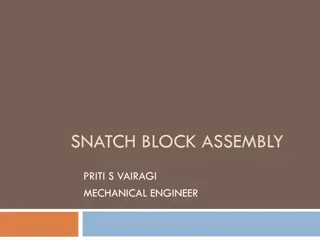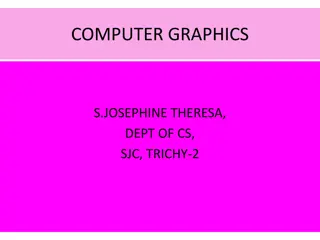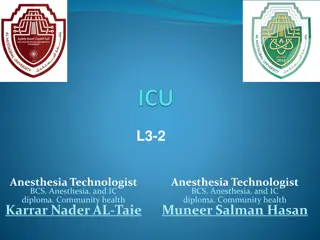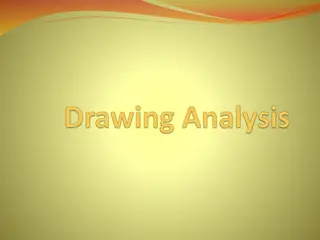Mechanical Engineering Curriculum Changes Fall 2024
The Mechanical Engineering curriculum is undergoing significant changes for Fall 2024, providing opportunities for students to adapt to a revised program. Changes include an improved design sequence, condensed math courses, and enhanced professional preparation with added elective options and a new
1 views • 12 slides
Understanding Mechanical Ventilator Sensors and Actuators
Explore the essential components of mechanical ventilators, including sensors like pressure and flow sensors, actuators, and oxygen sensors. Learn about the functions and characteristics of these sensors and how they contribute to the operation of mechanical ventilators designed to assist patients w
6 views • 20 slides
Overview of Farm Power Sources and Utilization in Agriculture
Farm power sources in agriculture include human, animal, mechanical, and renewable energy. Human power is costly but versatile, while animal power is traditional and provides manure. Mechanical power from tractors and engines is efficient. India's farm power sources reflect a mix of traditional and
0 views • 12 slides
Understanding Force Transmissibility in Mechanical Systems
Force transmissibility in mechanical systems is crucial for analyzing the relationship between applied forces and resulting vibrations. This outline covers key concepts such as base excitation, motion transmissibility, and rotating unbalance, providing insights into how forces are transmitted and am
0 views • 16 slides
Understanding Pulley Systems in Mechanical Engineering
Pulleys play a crucial role in mechanical engineering, offering fixed and movable designs that aid in changing the direction of hoisting appliances. Different types, including fixed, movable, and multiple pulley systems, provide mechanical advantage and stability in lifting loads. Utilizing multiple
1 views • 11 slides
Exploring Orthographic Drawing in Design and Technology Education
Delve into the world of orthographic drawing through St. Columba's Design and Technology Department's S1 Graphic Communication program. Discover the significance of orthographics in visualizing 3D objects as 2D drawings, learn about orthographic views like Elevation, Plan, and End Elevation, and exp
0 views • 8 slides
Tonal Shading Drawing Techniques Lesson for Upper KS2
Develop your drawing technique in creating tone with light, medium, and dark tones using cross-hatching, blending, and stippling. Apply these techniques to make objects appear 3D. Explore the importance of tone in drawing, experiment with different shading techniques, and apply them to compositions.
6 views • 6 slides
Pixel Array Status and Drawing Rules for High-Resistivity Epi Design
This collection of images and descriptions provides an overview of the pixel array status as of April 26, 2019, along with drawing rules for high-resistivity epi design. The pixel array features various components such as Pixel_S1, Pixel_S3, and the overall array structure. Drawing rules highlight t
4 views • 9 slides
Understanding Symmetrical DDA and Bresenham's Line Drawing Algorithm
The content discusses the Symmetrical DDA (Digital Differential Analyzer) and Bresenham's Algorithm for line drawing in computer graphics. Symmetrical DDA generates lines from differential equations, while Bresenham's Algorithm iteratively changes coordinate values to draw lines effectively. The pro
0 views • 11 slides
Understanding Mechanical Devices for Movement
Delve into the world of mechanical devices used to generate movement, focusing on levers as a critical mechanism for creating mechanical advantage. Learn about the different classes of levers, their applications, and how they enhance efficiency in various tools and equipment. Explore concepts such a
0 views • 8 slides
Introduction to Mechanical Engineering: Exploring Career Opportunities and Roles
This content delves into the world of mechanical engineering, covering topics such as the characteristics of students interested in engineering, the distinction between engineers and scientists, and the functions of engineers in research. It also provides insights into the differences between engine
6 views • 41 slides
Evolution of Arcade Games: From Mechanical to Digital (1870-1977)
Explore the fascinating journey of arcade games from mechanical and electro-mechanical devices in the 19th century to the birth of digital games in the mid-20th century. Witness the transition from coin-operated amusement machines to early digital arcade games and home consoles, shaping the gaming i
0 views • 37 slides
ME 4182 & GT 4823: High-profile Mechanical Design Course at Georgia Tech
Spearheading an innovative experiment, ME 4182 & GT 4823 aim to redefine mechanical design education by fostering interdisciplinary collaboration, problem-solving skills, and real-world applications. Students engage in team-based projects to design mechanical solutions, present detailed specificatio
0 views • 36 slides
Exploring Drawing Capabilities in Pygame: Shapes, Multimedia, and More
Utilize Pygame to go beyond drawing rectangles and explore drawing circles, lines, shapes of any format, and importing images. Enjoy playing music and multiple sounds simultaneously. Learn about useful functions in the Draw module and how to draw various shapes onto Surfaces using parameters and fun
0 views • 26 slides
Department of Mechanical Engineering DAB Meeting Presentation Summary
The Department of Mechanical Engineering held a DAB Meeting Presentation on 23rd January, 2021. The meeting agenda included topics like approval of previous minutes of meeting, academic progress of students, online teaching activities, faculty contributions, and more. The minutes of the meeting disc
1 views • 36 slides
Understanding Mechanical Injuries: Types, Classification, and General Principles
Mechanical injuries encompass a variety of harms caused to the body, mind, reputation, or property. These injuries can be classified into medical, legal, and medico-legal categories based on factors like intentionality. The types of mechanical injuries range from blunt force trauma to thermal, chemi
0 views • 79 slides
Creating Interactive Drawing App in Flutter
Learn how to create an interactive drawing app in Flutter using GestureDetector for touch input, CustomPaint for rendering, and storing drawing information dynamically. Implement features like color selection, line width adjustment, and gesture detection to enable users to draw on the screen efficie
0 views • 19 slides
Understanding Mechanical Ventilation in Anesthesia Practice
Anesthesia technologists play a crucial role in managing artificial ventilation, including concepts like Invasive Positive Mechanical Ventilation (IPMV), Fraction of Inspired Oxygen (FIO2), Tidal Volume (VT), Peak Flow Rate, Respiratory Rate, Minute Volume (VE), I:E Ratio, and more. They monitor and
0 views • 27 slides
Introduction to Engineering Drawing and Techniques
Engineering drawing is a fundamental aspect of communicating ideas and designs in the fields of Mechanical, Electrical, and Civil Engineering. This form of visual communication utilizes lines to represent object surfaces, edges, and contours. Various drawing methods such as Freehand, Instrument-base
0 views • 55 slides
Introduction to Engineering Drawing Language and Drawing Tools
Engineering Drawing Language uses lines to depict object surfaces, edges, and contours, while Freehand Drawing is sketched without instruments. Drawing Instruments ensure precise drawings to scale. Learn to draw horizontal and vertical lines, and angles using drawing tools like T-Square and triangle
0 views • 29 slides
Nature Drawing Tasks for Art Class
Complete a series of nature drawing tasks including recreating shells, creating skull drawings, experimenting with mark making techniques, and working on charcoal drawings. Reflect on your work to improve and develop your drawing skills further.
0 views • 6 slides
Raster Graphics and Scan Conversion in Computer Graphics
This lecture covers various topics related to raster graphics and scan conversion in computer graphics. It includes issues with scan converting a line, generalized line drawing algorithms, and the midpoint circle drawing algorithm. Additionally, it explores deriving mathematical expressions for draw
0 views • 21 slides
Understanding Machines: Making Work Easier and Mechanical Advantage
Machines are devices that simplify work by increasing force, decreasing force, increasing distance, or changing direction. They operate by transferring energy and work from input to output, with mechanical advantage enhancing force ratios. This summary explores the principles of machines, work done,
0 views • 10 slides
Bresenham Line Drawing Algorithm Explained with Examples
Bresenham Line Drawing Algorithm is a method used to generate points between starting and ending coordinates to draw lines efficiently. This algorithm involves calculating parameters, decision parameters, and iteratively finding points along the line. Two example problems are provided with step-by-s
0 views • 8 slides
Master AutoCAD 2021 Drawing Tools and Techniques
Explore the powerful features of AutoCAD 2021 including drawing tools for setting limits, line weight adjustments, hatch tool for generating hatch lines, and gradient application. Learn how to set drawing limits, customize line weights, and optimize your drawings efficiently in AutoCAD. The tutorial
0 views • 8 slides
Understanding Mechanical Ventilation in Anesthesia Technology
Mechanical ventilation plays a crucial role in assisting patients with breathing difficulties by delivering oxygen and removing carbon dioxide. It involves two primary types: Negative Pressure Ventilation (NPV) and Positive Pressure Ventilation (PPV). NPV helps patients with conditions like chronic
0 views • 19 slides
Newton's Interpolating Polynomials in Mechanical Engineering
Explore Newton's interpolating polynomials in the context of Mechanical Engineering, specifically focusing on numerical methods and interpolation techniques. Dr. Mohamed El-Shazly, an Associate Professor of Mechanical Design and Tribology, guides students through the concepts and applications of New
0 views • 17 slides
An Overview of Finite Element Method in Mechanical Engineering
Finite Element Method (FEM) in mechanical engineering is a powerful numerical technique involving dividing a domain into finite elements, establishing relations between variables, and assembling elements to analyze a system. This method is fundamental for solving one-dimensional problems and approxi
0 views • 63 slides
Metal Drawing Process for Creating Hollow Vessels
Metal drawing is a cold forming process that transforms a flat sheet metal blank into a hollow vessel without wrinkles or fractures. By applying force with a punch, the metal is drawn into a die cavity to shape the blank into a cup-like form. This process involves setup similar to blanking but with
0 views • 19 slides
Understanding Mechanical Properties of Nanostructured Materials
Nanostructured materials exhibit unique mechanical properties due to factors like grain boundary structure and dislocation movement. Reduction in grain size can enhance strength and hardness while reducing ductility. Nanomaterials may reach theoretical strength levels, significantly higher than sing
0 views • 23 slides
Understanding Machines: Calculating Mechanical Advantage and Efficiency
In the world of machines, understanding what a machine is, how to calculate Mechanical Advantage (M.A.), and Efficiency is crucial. Machines alter force, distance, or direction to make work easier but do not multiply work. By assessing input force, distance, and work alongside output force, distance
0 views • 17 slides
Understanding Robotics: Components, Joints, and Manipulators in Mechanical Engineering
Explore the world of robotics through an in-depth analysis of the key components, mechanical elements, manipulator joints, end-effectors, and types of robots used in production engineering and mechanical design departments. Learn about joints, links, degrees of freedom, and how robot manipulators ar
0 views • 22 slides
Bresenham's Circle Drawing Algorithm Explained
Bresenham's Circle drawing algorithm is a fast and efficient method for drawing circles using integer arithmetic. It divides the circle into octants and selects the nearest pixel positions to create smooth arcs. This algorithm is widely used for graphics applications due to its speed and accuracy.
0 views • 15 slides
Robotics and Mechanical Design at Minia University
Explore the world of robotics and mechanical design at Minia University's Production Engineering and Mechanical Design Department. From the Kinematics of Two Industrial Robots to the renowned PUMA 560, immerse yourself in cutting-edge technology and innovative research led by experts like Dr. Ahmed
0 views • 13 slides
Understanding Mechanical Linkages in High-Performance Manufacturing
Explore the world of mechanical linkages, including the effects of friction on machine operation, operation of machine linkages, and the roles of cams and turnbuckles. Friction is discussed as a force affecting everyday tasks, while cams and camshafts are highlighted for their role in sewing machine
0 views • 8 slides
Introduction to Press Tools and Presses Classification
Press tools are specialized tooling used for various forming processes like blanking, piercing, shearing, bending, drawing, and more. Presses are classified based on power source, frame type, slide actuation method, and number of slides. Mechanical and hydraulic presses are distinguished by power so
0 views • 20 slides
Understanding Mechanical Ventilation in COPD Exacerbation
In a case of a 64-year-old woman with COPD exacerbation, managing respiratory distress is crucial. Initiating systemic corticosteroids, doxycycline, and nebulizers while closely monitoring the patient is important. However, in cases where non-invasive ventilation is ineffective, the patient may requ
0 views • 22 slides
Main Manufacturing Processes to Produce PM - Mechanical, Chemical, Electrochemical
The process of producing PM involves various manufacturing processes such as mechanical grinding and milling, physical-mechanical production methods, chemical production methods, and electrochemical production methods. Mechanical processes include grinding and milling using jaw crushers, hammer grin
0 views • 12 slides
Developing Drawing Techniques for Tone in Lower KS2 - Lesson 2
In this lesson, students will enhance their drawing skills by experimenting with techniques such as cross-hatching, blending, and stippling to create tone. They will learn about key terms like light, medium, dark, shadow, and highlight, and engage in activities that help them understand the importan
0 views • 5 slides
Understanding Production Drawings and Mechanical Drawing Reading
Production drawings, also known as working drawings, provide essential information for manufacturing machines or structures. They include dimensions, material details, assembly instructions, and more. This legal document ensures manufacturing standards adherence and serves as a guide for production.
0 views • 20 slides






































